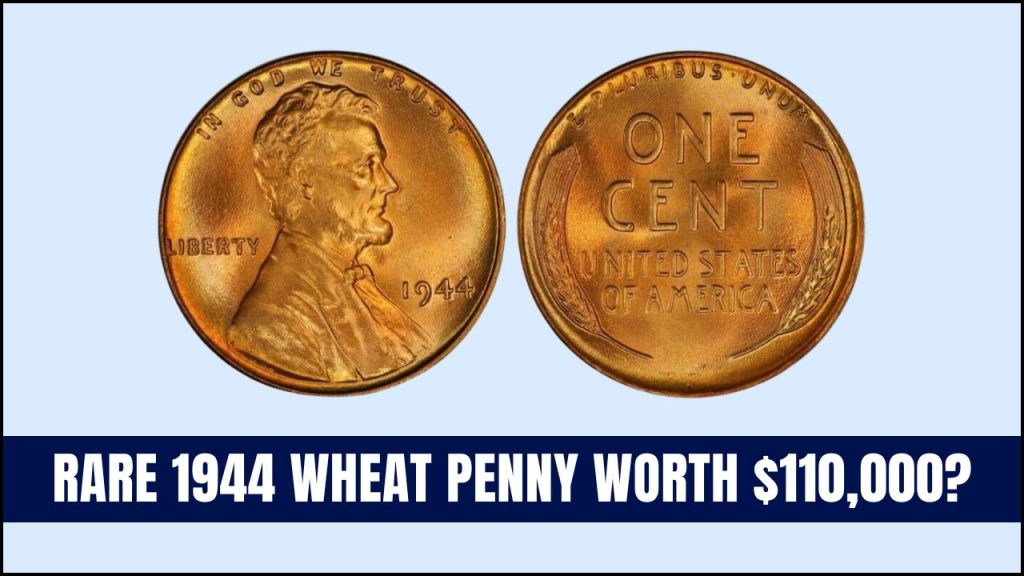
What if a single coin in your drawer could be worth a small fortune? That’s the story behind the rare 1944 Lincoln Wheat Penny—specifically, a version without a mint mark and made of steel instead of copper. At first glance, it looks like any other penny. But under the right circumstances, it could fetch up to $110,000 at auction.
Let’s dig into what makes this humble coin so special and how you can identify one in your collection.
Why Are Some 1944 Wheat Pennies So Valuable?
During World War II, copper was urgently needed for military purposes—shell casings, wiring, and essential wartime manufacturing. So in 1943, the U.S. Mint temporarily changed the composition of pennies from copper to steel coated with zinc. These steel cents had a silver-grey appearance and were highly magnetic.
In 1944, the Mint resumed using copper and zinc for pennies. But here’s where history took a twist: a few leftover steel blanks (also called planchets) from 1943 were accidentally fed into the coin presses. The result? A handful of 1944 pennies struck in steel—an error that turned these coins into ultra-rare collector’s items.
While millions of 1944 copper pennies were produced, the steel versions number only a few dozen, making them incredibly valuable.
1944 Wheat Penny Composition Comparison
| Coin Type | Material | Weight | Rarity |
|---|---|---|---|
| 1944 Standard Wheat Penny | 95% Copper, 5% Zinc | 3.11g | Common |
| 1944 Steel Wheat Penny | Steel | 2.7g | Extremely Rare |
| 1944 Error Coins (Various) | Copper/Steel | Varies | Rare |
Rare Bicentennial Quarter Worth Nearly $201K – Plus 6 More Coins Valued Over $25K Each
5 Rare Bicentennial Quarters Worth $2.5 Million – Fact vs. Fiction, Could Your Coin Be Valuable?
The $51 Million Rare Bicentennial Quarter – And 5 More Coins That Could Be Worth a Fortune
Common 1944 Wheat Penny Errors That Increase Value
The 1944 steel penny is the superstar, but other minting errors from that year are also prized by collectors. Here’s a look at some of the most desirable error coins and how much they can be worth.
1944 Steel Wheat Penny
- Struck on a leftover 1943 steel planchet.
- Has a silver-grey color and is magnetic.
- Value: Up to $110,000, depending on condition.
1944 Copper Penny with Doubled Die Error
- Features a doubled imprint, especially noticeable in “LIBERTY” or “IN GOD WE TRUST”.
- A result of a die misalignment during minting.
- Value: Between $500 and $5,000, depending on how strong the doubling is.
1944 Off-Center Strike Penny
- The coin was misaligned during striking, resulting in a partial or skewed design.
- These coins look visibly “off” from regular pennies.
- Value: $100 to $1,500, based on the degree of the error.
1944 Clipped Planchet Penny
- A portion of the blank was clipped off before striking.
- Leaves a distinct curved or flat cut on the edge of the coin.
- Value: Ranges from $50 to $500.
How to Identify a Rare 1944 Wheat Penny
If you’ve got a jar of old coins or inherited a family collection, here’s how to check if you have one of these rare and valuable 1944 Wheat Pennies.
Step-by-Step Identification Guide:
- Color Check
- A normal 1944 penny is copper-colored.
- If yours is silver-grey, it could be the rare steel version.
- Magnet Test
- Use a small magnet.
- Steel pennies will stick. Copper ones will not.
- Weight Check
- Use a digital scale.
- Copper pennies weigh 3.11 grams.
- Steel pennies weigh 2.7 grams.
- Look for Errors
- Use a magnifying glass to inspect the date and text.
- Look for signs of doubling or misaligned prints.
- Get It Verified
- Suspect you’ve got a rare one.
- Send it to professional graders like PCGS or NGC for authentication and official grading.
Current Market Value of Rare 1944 Wheat Pennies
Market value can vary depending on the condition (circulated vs. mint) and collector demand. Here’s a quick snapshot of how much these coins are worth today:
| Coin Type | Circulated Value | Mint Condition Value |
|---|---|---|
| 1944 Steel Penny | $30,000 – $60,000 | Up to $110,000 |
| 1944 Copper Doubled Die Penny | $500 – $2,000 | Up to $5,000 |
| 1944 Off-Center Strike Penny | $100 – $800 | Up to $1,500 |
| 1944 Clipped Planchet Penny | $50 – $200 | Up to $500 |
Is Your 1944 Penny a Hidden Treasure?
In the world of coin collecting, even the tiniest details can make a huge difference. While the majority of 1944 Wheat Pennies are common and hold little more than sentimental value, a rare few have become six-figure collectibles due to minting mistakes.
So, what should you do if you stumble upon a 1944 penny?
- Test it. Use the magnet and scale method.
- Examine it. Look for off-center strikes, clipped edges, or doubled lettering.
- Get help. When in doubt, show it to a professional numismatist or certified dealer.
You never know—your old coin box could be hiding a treasure. Many rare coins are discovered in estate sales, family collections, or even in loose change that’s been sitting in a drawer for decades.
Final Thoughts
The story of the 1944 steel Wheat Penny is a perfect blend of history, error, and unexpected value. It reminds us that even small items can carry immense stories—and, in rare cases, incredible worth.
Whether you’re a seasoned collector or just someone curious about what’s hiding in your coin jar, the 1944 Wheat Penny is a shining example of why it’s always worth taking a second look.
Who knows? You might already be holding onto your very own $110,000 penny.